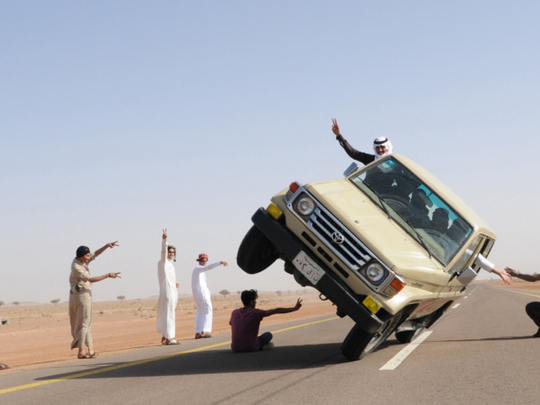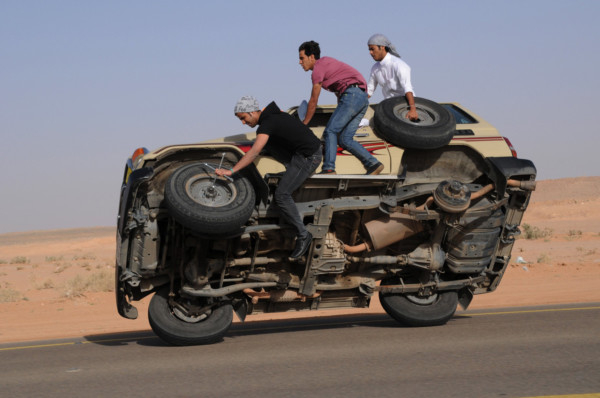
On the roads of Saudi Arabia, death lurks masquerading as thrill, luring youngsters seeking a rush of adrenaline. It’s a daily ritual of sorts, with young men driving cars at very high speeds and engaging in antics that could harm not just them, but also those who ride with them or just happen to be in the vicinity. “Tafheet”, as it is called in Arabic, or “drifting”, has become a subculture, a potentially fatal underground sport for the youth, so much so that it is sometimes referred to as street terrorism and an outright menace to the public.
Concerned about the rising popularity of tafheet, the Saudi Arabian government recently imposed hefty penalties for the law breakers. First-time offenders are fined 20,000 riyals (Dh19,585) and the car is impounded for 15 days. The fine is doubled second time and the vehicle impounded for 30 days. The third time the penalty goes up to 60,000 riyals, and the vehicle is confiscated for good. Earlier, the fine was just 1,000 riyals.
While many Saudis have welcomed the imposition of fines, they are doubtful that it would stop this “national hobby” — that has its own terminology — right across the Gulf, including the United Arab Emirates, Qatar and even areas in north Jordan because of the vast open spaces and highways. It is Saudi Arabia, however, where the underground sport remains particularly notorious yet popular.
Erfan Matasharan, a car sports reporter and photographer for Al Arabiya channel, doesn’t mince words. “I look at tafheet as a popular national sport, just like football.” He feels sorry because he can’t photograph all of the drivers in the streets and highways as “most won’t agree to show their faces or their number plates for fear of the authorities”.
Speaking on the changes in the traffic law, Saudi Shura Council member Thuraya Al Areed said the new fines would almost certainly act as a deterrent and “will quickly put an end to this phenomenon” which is dangerous to pedestrians and to the public.
However, Saudi columnist Adel Al Harbi was not as sanguine. He proposes criminal action against repeat offenders. “These drivers are not only attempting suicide but are endangering pedestrians and spectators, too. We need to have laws that make people think twice or even thrice before even jumping a red light, let alone indulging in tafheet.”
Only time will tell whether the stricter penalty will be effective.
This underground culture started in the 1970s when the road infrastructure was being laid in the region. In “Joyriding in Riyadh: Oil Urbanism and Road Revolt”, author Pascal Menoret says, “Car drifting emerged after Riyadh was planned and oil became the main driver of the economy. For young rural migrants it was a way to reclaim alienating and threatening urban spaces.”
There are two factors to consider here: joyrides have become common all over the kingdom, but perhaps more concentrated in some areas; they have become a fad, a craze for some and a hard habit to break. Second, for many Saudi young men aged 18 or 19 and even those in their 20s, joyrides have come to mean reclaiming the roads and highways of Saudi Arabia, come night or day.
Saudi official statistics show there is a traffic accident every second of the day and that at least 20 people — mostly young men — die every day because of speeding, drifting or reckless driving. In the 1990s joyrides literally occurred every 11 minutes on average in various parts of the kingdom. And in the first three months of 2014 the Riyadh Police arrested 750 for incidents of drifting.
Today the authorities may also have to reckon with the tentacles of internet and social media. Thousands of videos of young Saudi drivers are being uploaded on social media websites, including YouTube, and they are seen by millions around the world. Saudi Arabia has the highest numbers of views for such videos internationally. These videos only reinforce this youth culture.
With a huge entourage of followers, especially on Facebook, some of these drivers have become more daring in their acts. Some have even adopted such pseudonyms as Al Motahawer (the reckless), Al Erhabe (the terrorist), Crush and the Joker. Al Erhabe’s video of his antics has garnered more than 4 million views.
But while social media poses a challenge, the government could also make use of it to spread the message of safety and the dangers of drifting.
Meanwhile, deaths have continued to occur on the roads. Take the case of 24-year-old Ahmad Shitaiwi Al Ruwaili, popularly known as King Al Natheem. He was first sentenced to 10 years in jail in 2014 for joyriding. His sentence was commuted to six years and 600 lashes. He was then set free and asked to repent, promise that he will not indulge in drifting again and memorise chapters of the Quran.
However, the lure of fast and reckless driving got the better of him. On the morning of September 23, he took to the steering wheel again. He was drifting so fast that he rammed the vehicle into a wall and died while the passenger with him suffered injuries.
Then there was the case of Faisal Al Otaibi who was arrested in 2005 after three teenage passengers in his car died in the joyride. Al Otaibi was sentenced to death, but later his sentence was reduced to 20 years in prison and 3,000 lashes.
So why do they do it? There is no definitive answer. Suhail Janoudi, a 27-year-old sales clerk, says he enjoys watching the races even late at night, away from the eyes of the law. “Why do young people watch? Simply because they have nothing else to do.”
Fahad Al Mutairi put it this way: “I don’t understand why this sport is even popular among Saudi youth. Perhaps it is because of the lack of recreation activities that might interest them.”
Such views are widespread. More units are being created with sociologists and criminologists to study this phenomenon. Some of the spectators or those involved in these antics say they do it because of tufush, a colloquial Arabic term roughly meaning idleness, desperation or having nothing better to do.
Sulayman Al Shulukhi, 29, who races every weekend, says he was practically brought up on drifting. “It gets ingrained in you when you are a kid, and stays with you as you grow up.” He goes drifting outside the city with his friends until very late in the night.
People believe that mundaneness of life drives youngsters to this life-threatening activity. “Some say this is because young men have plenty of free time and no other entertainment, and call for a special arena for drifters,” Mshari Al Thaydi wrote in “Asharq Al Awsat”. This view is being practised in some parts of Saudi Arabia.
Steps are being taken to keep young people off the streets by providing them designated places for drifting. Saudi Saeed Al Hamouri legally practises drifting in arenas. He says parents must be firm with their children and not hand them cars at the drop of a hat. His colleague Abdo Feghali, a professional driver and a drifter, organises the annual Car Park Drift to make people more aware of the dangers of tafheet, urging them to follow safety procedures.
Similarly Ahmad Al Ameri, the UAE Drift champion, promotes safe driving. He practises drifting in a stadium “Isn’t it better to drive safely? Here you can drive as long as you like,” he told CNN reporter Mohammad Jamjoum. On a humorous note, Saudi columnist Ibrahim Al Ammar wrote in “Arab News”, “Car chases and drifts in Hollywood movies seem laughably amateurish compared to what Saudi teenagers can do.”
Marwan Asmar is a commentator based in Amman. He has long worked in journalism and has a PhD in Political Science from Leeds University in the UK.













